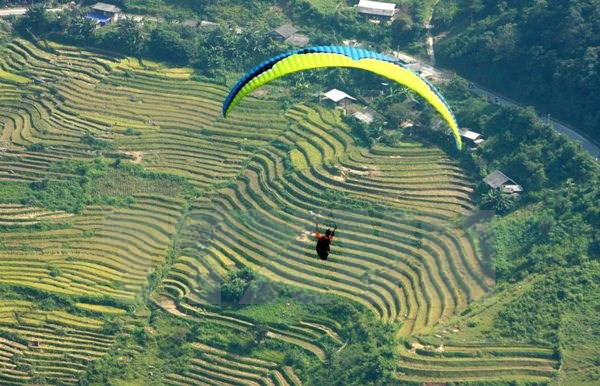To fully tap potential, the region’s provincesof Hoa Binh, Son La, Lai Chau, Dien Bien, Phu Tho, Lao Cai, Yen Bai and HaGiang have enhanced links for sustainable tourism development.
Since the eight provinces signed a tourismcooperation agreement in 2008, they have focused on building infrastructurefacilities, restoring cultural and historical sites, and traditional craftvillages, preserving and promoting the values of cultural and geographicheritages and natural landscapes, and building new tourism products.
Through the cooperation programme, many tourismproducts of the localities have been included in travel agencies’ packagetours, becoming attractive to tourists.
The region’s tourism development cooperation hasyielded substantial outcomes, with visitor numbers increasing year on year. In2016, the number of tourists to the eight provinces reached nearly 18 million,up 11.8 percent over the previous year. Of the total, 6.4 million wereovernight visitors, including 1.2 million foreigners, an increase of 11percent.
In the first half of 2017, the region welcomed13.6 million holidaymakers and earned 10.1 billion VND in tourism revenue, 80percent and 70 percent of yearly goals, respectively.
However, besides these encouraging results,there remain obstacles hindering regional tourism development includingdifficult terrain, poor infrastructure and limited resources, according toinsiders.
The region lacks high-class tourism services tokeep tourists longer, they said, adding that promotion has also been poor, withfew travel firms operating in the region.
Therefore, the provinces should hunt investmentin tourism and road infrastructure, they suggested.
They also agreed on the need for more humanresources training, the most serious problem facing the provinces’ tourism, as60 percent of local tourism workers have no professional training.
Home to more than 30 ethnic minority groups, theregion should focus on developing community-based tourism to introduce touriststo the beauty of the people, cultures and lifestyles of local ethnicminorities, they said.
Luu Duy Linh, Deputy Director of the Hoa Binh provincialDepartment of Culture, Sports and Tourism, said regional provinces have alreadydeveloped a road tourism route, National Road 6, connecting Hanoi, Hoa Binh,Son La, Dien Bien and Lai Chau.
The provinces are also surveying a river tourismroute along the Da River that allows tourists to see the Hoa Binh, Son La andLai Chau hydropower reservoirs, he said, adding that the route is expected tobe launched at the end of this year, National Tourism Year 2017 – LaoCai-Northwest.
Linh stressed the need for northwestern provinces to promotetheir strengths and create distinctive products based on unique culturalvalues, landscapes, and the environment.
He said Hoa Binh will focus on the culture ofthe Muong ethnic group as it is a typical feature of the province while Son Laand Dien Bien will pay attention to the cultures of Thai, Mong and Dao ethnicpeople.
According to Ha Van Sieu, Deputy DirectorGeneral of the Vietnam National Administration of Tourism, NationalTourism Year 2017 in the northwest will awaken the region’s potential and openup opportunities for the development of tourism.
Themed “Colours of the Northwest”, the eventoffers a chance for the provinces to introduce their tourism potential,cultural identities and heritage values to domestic and international visitors,while creating a breakthrough in tourism development, building new products andenhancing links among localities in the field, he said.
To serve National Tourism Year 2017, the regionhas invested in developing eight attractive tourism products, includingcommunity-based tourism, tours to discover terraced fields and mountainousmarket-days, spiritual tourism along the Red River and the Da River, and toursto see flowers.
 A person goes paragliding at a paragliding festival at Khau Pha mountain pass, Mu Cang Chai district, the northwestern province of Yen Bai (Photo: VNA)
A person goes paragliding at a paragliding festival at Khau Pha mountain pass, Mu Cang Chai district, the northwestern province of Yen Bai (Photo: VNA)There are also a tourism programme to discoverroads where Vietnamese soldiers marched during the Dien Bien Phu Campaign andtours designed for those who want to conquer the summits of Vietnam includingFansipan in Lao Cai (3,143m), Phu Ta Leng in Lai Chau (3,040m) and Chieu LauThi in Ha Giang (2,412m).
The region hopes to welcome 2.3 millioninternational visitors and 14 million local tourists by 2020.-VNA






























